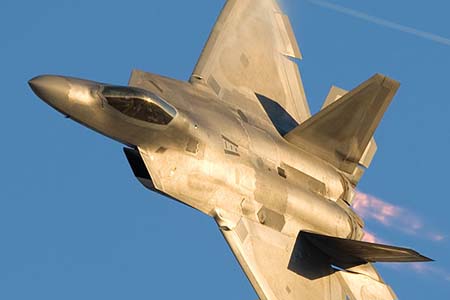Usin g two specially configured F-22s during the latest Joint Expeditionary Force Experiment, the Air Force demonstrated it could transfer real-time sensor data acquired by the new fighters to ground stations at JEFX central at Nellis AFB, Nev., and Langley AFB, Va., according to a May 2 release from F-22-lead contractor Lockheed Martin. The two-week JEFX included two F-22s outfitted with “an experimental version of the Tactical Targeting Network Technology waveform developed by Rockwell Collins,” states Lockheed, adding that the F-22s flew in “realistic scenarios” that highlighted the Raptor’s “significant non-traditional intelligence-surveillance-reconnaissance capabilities.” According to Lockheed F-22 general manager Larry Lawson, “This is the first time in history that F-22 sensor data was down-linked to the combined air operations center using a tactical network.” According to the company release, the effort required both the Air Force and Lockheed to overcome “enormous security challenges.” The experiment also linked the F-22s to other airborne platforms as well as ground stations, making it a “huge first step” for the F-22s toward becoming net-enabled, said Mark Jefferson, director of Lockheed Martin Aeronautics Horizontal Integration. The F-22 pilots, he said, “stayed pretty busy conducting offensive counter air and destruction of enemy air defenses air dominance missions as well as dynamic targeting attacks with F-16s and non-traditional ISR collection events during the exercise, while also simultaneously piping classified sensor data to the CAOC.”
g two specially configured F-22s during the latest Joint Expeditionary Force Experiment, the Air Force demonstrated it could transfer real-time sensor data acquired by the new fighters to ground stations at JEFX central at Nellis AFB, Nev., and Langley AFB, Va., according to a May 2 release from F-22-lead contractor Lockheed Martin. The two-week JEFX included two F-22s outfitted with “an experimental version of the Tactical Targeting Network Technology waveform developed by Rockwell Collins,” states Lockheed, adding that the F-22s flew in “realistic scenarios” that highlighted the Raptor’s “significant non-traditional intelligence-surveillance-reconnaissance capabilities.” According to Lockheed F-22 general manager Larry Lawson, “This is the first time in history that F-22 sensor data was down-linked to the combined air operations center using a tactical network.” According to the company release, the effort required both the Air Force and Lockheed to overcome “enormous security challenges.” The experiment also linked the F-22s to other airborne platforms as well as ground stations, making it a “huge first step” for the F-22s toward becoming net-enabled, said Mark Jefferson, director of Lockheed Martin Aeronautics Horizontal Integration. The F-22 pilots, he said, “stayed pretty busy conducting offensive counter air and destruction of enemy air defenses air dominance missions as well as dynamic targeting attacks with F-16s and non-traditional ISR collection events during the exercise, while also simultaneously piping classified sensor data to the CAOC.”
Trainees in Basic Military Training and technical school no longer have the option to try alternate PT drills if they fail an initial assessment, according to a policy change the Air Force made in April. The move is part of a larger shift out of the classroom and into hands-on,…